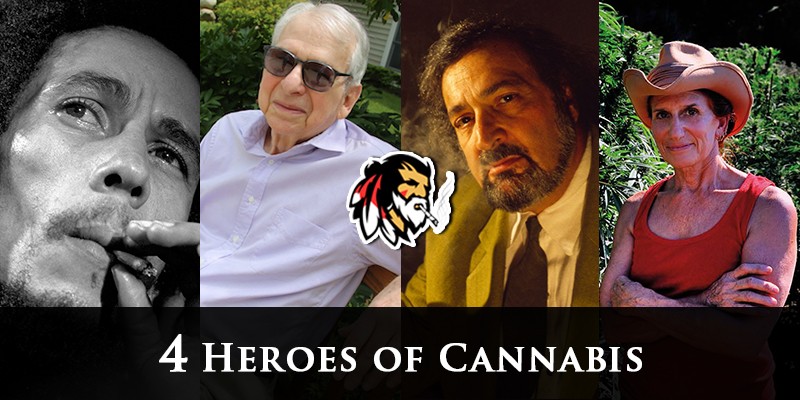Cannabis
4 Heroes of Cannabis
Now that we’re enjoying the perks that come with cannabis legalization, it’s easy to forget that this is the result of a long, hard process. Over the decades, countless people have advocated for cannabis rights. Here are four heroes who, in one way or another, contributed to the freedom that we now enjoy.
The Icon: Bob Marley
Cannabis has long been associated with introspection, and this association was never championed and presented to so many people, directly or indirectly, as it was by Bob Marley. For those living in dim caves in the foothills of Kyrgyzstan, Bob Marley was a reggae musician and one of the best-selling and most famous artists of the 20th century. Even if you haven’t heard his music, you’ve seen his face plastered on everything from bongs to boom boxes. In fact, his very image has become ubiquitous with cannabis consumption.
It’s worth noting that Bob Marley utilized cannabis for spiritual reasons. A dedicated Rastafarian, he believed that cannabis use was widespread in the Bible, and interpreted a number of biblical passages to condone and even encourage its use. He believed that the psychotropic effects of cannabis encouraged introspection and meditation, which could lead people to discover things about themselves and decide on the right courses of action.
In his own words: “When you smoke herb, herb reveal yourself to you. All the wickedness you do, the herb reveal itself to yourself, your conscience, show up yourself clear, because herb make you meditate. Is only a natural t’ing and it grow like a tree.”
While Marley supported legalization, and was politically active in other areas (such as pan-Africanism), he is not known for being an active political advocate of cannabis. Instead, what Bob Marley contributed to cannabis culture was his role as an insightful, respectable, and (most importantly) hugely famous advocate for non-medicinal use of cannabis.
The Doctor: Dr. Lester Grinspoon
This particular hero had been on the course of becoming a villain when he discovered something that turned his life upside down . . .
It was the 1960s, and Grinspoon was watching with dismay as thousands if not millions of young Americans were getting into this sensational drug called marijuana. A keen professional, Grinspoon decided that he would set out to prove the error of their ways, in an effort to save these hippies from themselves. In his own words: “I had no doubt that it was a very harmful drug that was unfortunately being used by more and more foolish young people who would not listen to or could not believe or understand the warnings about its dangers.” He therefore decided that he would “define scientifically the nature and degree of those dangers.”
So Grinspoon dove into research. He reviewed existing data and writing on the subject, only to fail to discover anything that definitely proved what he—and, indeed, the mainstream public—had been taught to believe. Grinspoon discovered that—far from being ignored—the dangers of cannabis had in fact been exaggerated and/or fabricated altogether.
His findings culminated in the landmark publication Marihuana Reconsidered (1971), where he expounded on his findings and offered a credible academic voice to the message that cannabis advocates had been trying to get across for years. Grinspoon subsequently testified before Congress regarding the lack of dangers to cannabis, and as an expert witness in a number of trials regarding cannabis-related offenses.
The Late Bloomer: Jack Herer
Yes, this guy is the namesake of the famous strain, Jack Herer—and that distinction is a prize duly won. Interestingly, the man whose very name nowadays literally means cannabis didn’t try his first puff until he was thirty.
If nothing else, Jack Herer was one of the most outspoken cannabis advocates in history. Throughout his adult life, Herer campaigned relentlessly for the legalization of cannabis, as well as the expansion of hemp production for economic purposes. Sometimes this advocacy was direct, and at other times it served as the backdrop to larger political aims, such as his two (unsuccessful) runs for President of the United States.
His whirlwind career in cannabis advocacy hinged around The Emperor Wears No Clothes, his incredibly successful nonfiction book published in 1985. Thirty-four years later, The Emperor Wears No Clothes is on its twelfth edition, still in print, and regularly cited in arguments for legalization and rescheduling of the plant. It is basically the bible of cannabis advocacy, arguing not only for recreational legalization, but also touting the economic and industrial potential of the plant. To quote from the book’s back: “There is only one known annually renewable natural resource that is capable of providing the overall majority of the world’s paper and textiles; meet all of the world’s transportation, industrial and home energy needs, while simultaneously reducing pollution, rebuilding the soil, and cleaning the atmosphere all at the same time… and that substance is — the same one that did it all before — Cannabis Hemp… Marijuana!”
The Epileptic: Valerie Corral
One fateful day, a pilot experienced difficulty flying his small plane over Nevada. In his struggle to control the aircraft, he ended up flying low over a civilian road and clipped a car, sending it careening off of the road. While no one knew it at the time, this incident would ultimately lead to huge victories in the arena of medical cannabis.
Valerie Corral was in that car, and in the ensuing crash she sustained a number of injuries which resulted in her experiencing continued migraines, shaking, convulsions, and seizures. Her husband had read that cannabis had been found to control seizures in mice, and she decided to give it a try. Lo and behold, it worked like magic!
But this wasn’t the end of her story. Valerie Corral only entered the public eye, and the annals of cannabis history, when she was arrested for cultivating cannabis (for her own medical use) in 1992. Prosecutors dropped the case, realizing how difficult it would be get a conviction by a sympathetic jury. They were arrested again a year later, and the district attorney announced that he would not prosecute them. Corral saw the power in her position—the state was acknowledging the medicinal potential of cannabis—and decided to act on it.
In 1993, Corral founded the Wo/Men’s Alliance for Medical Marijuana (WAMM), a non-profit organization to provide medical cannabis to patients—the first of its kind to be recognized by the U.S. government. While this did not spell the end of legal difficulties (the federal government continued attempting to prosecute well into the 21st century), WAMM was a milestone in the movement for medical cannabis rights, and Corral continued to advocate for medical cannabis, most notably through her role in the crafting and passing of the Compassionate Use Act of 1996.



Excellent info and article.